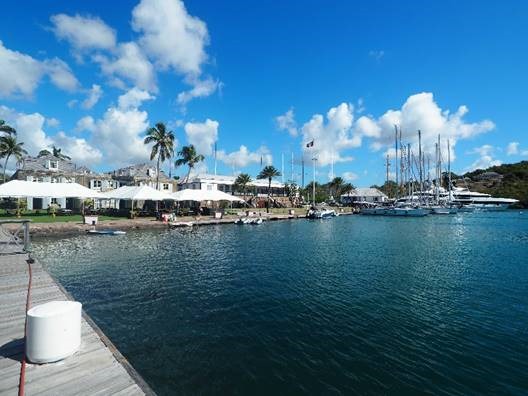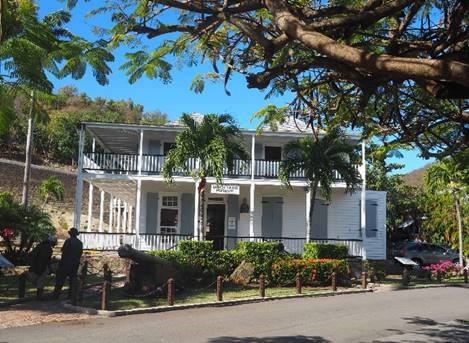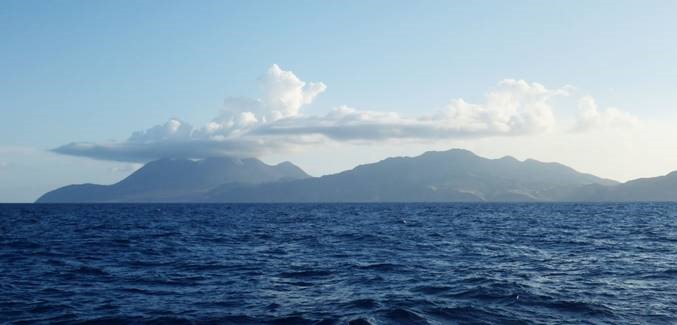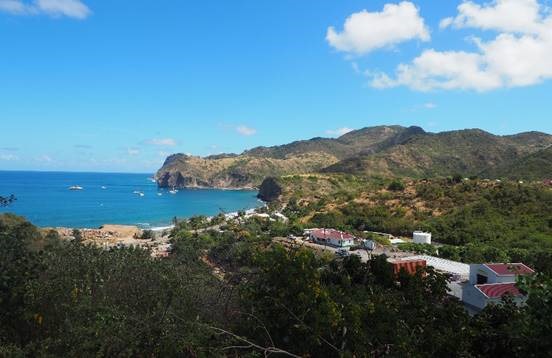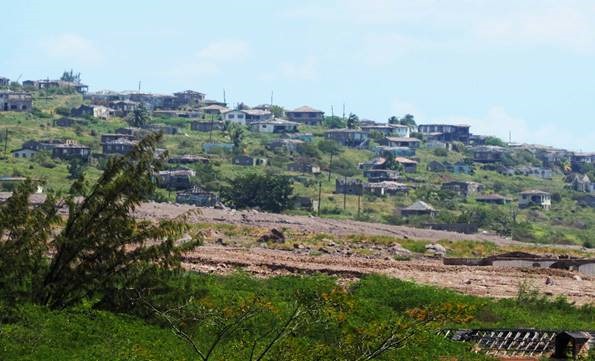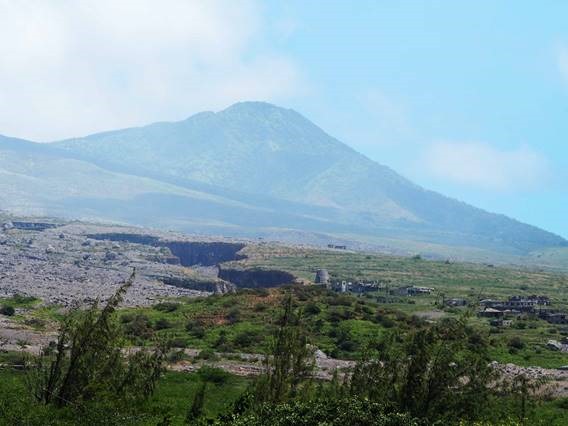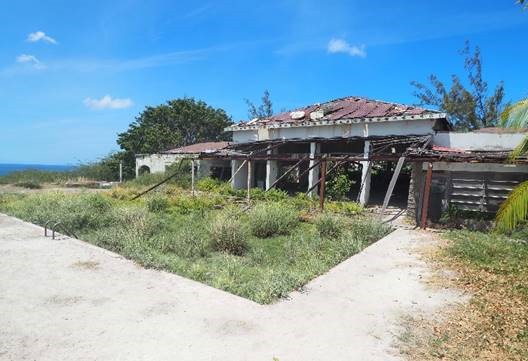20 March - discovering Montserrat

|
16:48.1N 062:12.5W We walked across to Nelson’s Dockyard to complete Customs and Immigration formalities out of Antigua. First thing in the morning, before the cruise ship tourists arrive in their droves, the place has a timeless tranquillity that puts it right up there with some of the most beautiful locations on Mother Earth. In the scrummage of the Customs offices though, we were confronted by the Monday morning queue of superyacht captains, giggly Sunsail charterers, ganga-infused liveaboards and uber-efficient Danes, all equally flummoxed by the stately dance between Port Authority, Customs and Immigration. I thought we were one step ahead of the rest with our ‘Sea Clear’ on-line form filling from Jolly Harbour, but I was wrong. Julie and I shared the queuing duties, but this was a couple of hours that we are not going to get back. We recovered with a cup of quite reasonable coffee on the waterfront, where I recognised David, the American whose boat had bumped us in the middle of the night in Freeman Bay, this time with his clothes on.
Nelson’s Dockyard, Antigua He and his wife are a delightfully sparky couple. They have another boat up in Maine, so we picked their brains. Aged 77, he races a Mini Cooper in his spare time. He keeps his boat ‘Vamoose’ in Antigua all the year round, but as he cannot afford the astronomical hurricane insurance premiums, she is effectively uninsured during the summer months. He assured me that he has a pot of money put aside to cover her loss, should the unthinkable happen.
The Captain’s House, Nelson’s Dockyard We broke the spinnaker out for the 20 mile sail to Montserrat that afternoon. It was a gloriously leisurely sail and I even tried to catch some fish to supplement the rather paltry meat supplies we have picked up in Antigua. No luck – just plenty of Sargasso weed. The weather was settled, dry and warm as it has been for the last three weeks or so – the wind sometimes gets up over 20 knots for a couple of days, but we have not needed the rain tent over the aft cabin since Martinique. Montserrat is an impressive lump, with a huge volcano at the southern end. So close to Antigua, it’s obviously much newer geologically, although as we pulled clear of Antigua’s south-western coast, we got a better view of the contrasts of that island: whilst much of it is developed, the more mountainous part looks much as Columbus might have seen it.
Montserrat from the north east Montserrat, on the other hand, has been growing. Following the catastrophic volcanic eruptions of 1995 – 97, which continued until 2005, Nature has been doing some serious land reclamation on both the east and west coasts. We stayed well to the north, but you could see the vapour rising from Mount Soufriere from over ten miles away. We rounded the northern tip of the island late in the afternoon and dropped anchor in Little Bay, on the western side, at sunset. There were half a dozen other yachts in the anchorage, which can be very exposed when there’s a northerly component in the wind.
Little Bay – now the main hub of the island In the morning, we went ashore to complete the immigration formalities. What a contrast with Antigua – all done in a few minutes. We emerged, slightly shellshocked, into the bright sunlight and met George Christian, a taxi driver, who offered to take us on a tour of the island. Montserrat is a British Dependent Territory, meaning that the UK provides defence, education, health and social security to the islanders. This was an issue when the volcano erupted in 1995 which I well remember as I was serving in the Ministry of Defence at the time. Evacuation plans, relocation, temporary accommodation in other parts of the island, the cost – human and fiscal – all played out in those very difficult years. So it was particularly interesting to see what had become of the people who remained. The original population of 12000 shrank massively: Mr Christian spent a few months in Milton Keynes (which he found quite difficult, as you might imagine). Today, the population is around 5000, all crammed into the northern half of the island.
Mount Soufriere grumbling away, Note the pyroclastic flows left and right of the obscured summit The civic planners had a field day. The new prison occupies the best piece of real estate on the island, on a fine promontory overlooking Little Bay and enjoying majestic sunsets every night. The Police Headquarters, perhaps the largest Government building we saw, sits just above it. As far as I could tell, the British Governor has an office above a Digicel shop (although apparently he has a nice house elsewhere). All the Government buildings are in one place on top of a hill; handy, as the Government is by far the largest employer on the island. Down in the valley below, the planned capital of Little Bay has not been built and everyone lives where they ended up as they were moved out of the original capital Plymouth in 1997. Only private money will see a new capital built now. I could not see a major investor making that kind of commitment here. We toured the ramshackle parking lot that makes up the fairly tatty Government quarter and then went to see the George Martin Centre, a cultural venue which is the pride and joy of the island. It was closed. The basketball centre was also closed. Sir George is a highly venerated figure here: he brought many fine musicians to the island to his recording studios and the locals treat him more like a deity than the chaps who he made famous – the Beatles. We stopped briefly at the National Trust where we saw a small exhibition of the effects of the volcanic eruption, the remains of a flower show and some nice elderly English ladies taking tea as they have probably done for decades. At the Montserrat Volcano Observatory, we watched a harrowing and dramatic film of the eruptions, the smothering of the landscape by terrifying pyroclastic flows, the evacuation of Plymouth, some remarkable ‘before and after’ footage’ of the mountain and the huge amount of ash that suffocated much of the island. This is a modern-day Pompeii, which for most Britons has dropped out of our consciousness as we focus on hurricanes, Brexit, global warming and a resurgent Russia. Then we set off in George’s taxi to see the impact for ourselves. It was very moving to hear his stories as we passed reminder after reminder of what life used to be like, of how it had changed forever and how the locals were having to adapt. Not rebuild, adapt. After a hurricane, you rebuild, sometimes better than before. After a volcano, your opportunities and your real estate shrink: there is no going back.
The outskirts of abandoned Plymouth – with the lava flow pushing through the middle George didn’t like England much, had a couple of years trying his luck in America, but eventually came home. He’s a well-informed, articulate man in his sixties with a family spread across England, North America and the Caribbean. He was gracious about the British Government’s efforts to help (I told him nothing of my small part until right at the end of the tour), stoic, deeply religious (a Methodist) and content with his lot.
A sugar mill clings to the edge of the lava flow; a reminder of a prosperous past The scale of the eruptions is breath taking. We crossed a dried-up riverbed with a sign telling us to avoid it in rain because of the risk of devastating mudslides. Apparently there is so much ash lying loose over the landscape that it will take another decade or so of rain before the ground stabilises. In the meantime, ash – and the mud it produces – is Montserrat’s main export (apart from the £28m in aid from DfID each year). As a result, we were occasionally almost forced off the empty roads by huge trucks thundering along, taking their precious cargoes of volcanic treasure down to a dusty barge moored in the only bit of Plymouth that it still used. Each time they go, they know that if the volcano erupts, they have just minutes to evacuate the ‘exclusion zone’. It puts the California Gold Rush into perspective…
George’s favourite hotel. The fertile ash has transformed the swimming pool into a lush garden. We stopped at the remains of a hotel where he used to go with his family for Sunday lunch. The views of the mountain and Plymouth were fantastic. The place was under two feet of ash and the swimming pool filled in with mud. The roof was collapsing as the termites munched steadily. There was a phone, just like the one on my desk, still in Reception and the place reminded me of a war zone. All the buildings in the exclusion zone were abandoned rapidly and you got a feeling that there might be someone hiding behind the shutters swinging idly in the breeze. There wasn’t: just the inexorable progress of Mother Nature reclaiming what is rightfully hers. In twenty years, Man’s attempt to dominate this bit of the planet will be almost indiscernible. Today, I found it an uncomfortable reminder of our powerlessness in the face of hurricanes, volcanoes, tsunamis and the rest. Partly because of the fine example of tolerance shown by George and his fellow islanders. I’m not sure how I would have reacted to the inescapable reality that everything I had built and worked for was now disappearing under a pile of ash, with absolutely no prospect of reversal. I know I would have reacted badly to the looting perpetrated by men from other Caribbean islands in the early days of the evacuation. I remembered the older stories from 1902 and the scene at St Pierre in Martinique and was thankful that the fine Governor of Montserrat, Frank Savage, had the sense to evacuate the population and save the lives of hundreds if not thousands. St Pierre, 115 years on, looked peaceful and beautiful and I imagine that in 100 years, Montserrat will be in a similar position. I hope George writes down his story so that his great-grandchildren, who rebuild Plymouth in 2115, know what all this was about.
Not a sign you see on Brighton Beach (even after several pints) |
